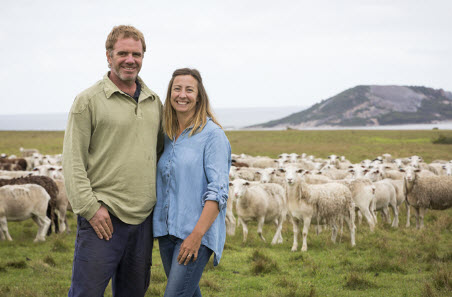Serradella success

Alan and Bec Hoggart of ‘The Duke’ at Condingup near Esperance, WA, have been involved in a three-year legume trial with their local ASHEEP (Association for Sheep Husbandry, Excellence, Evaluation and Production) grower group as part of MLA’s Producer Research Site program.
ASHEEP wanted to investigate using serradellas in kikuyu pastures, as sub-clovers have been patchy in the past few years on the south coast of WA due to red clover disease, which causes a reddening of the leaf and plant die-back. The Hoggarts run 5,600 Dorper–Wiltshire ewes for prime lamb production on 2,500ha in a mixed farming enterprise.
The trial on the Hoggarts' involved testing two varieties of serradella and sowing at different times of the year.
Trial paddocks were prepared for legume sowing:
- summer – kikuyu was heavily grazed and sprayed in early autumn
- autumn – kikuyu was heavily grazed until May and sprayed before sowing.
Legume sowing involved:
- summer – Margurita serradella at 25kg/ha and unscarified Bartolo bladder clover at 20kg/ha in February
- autumn – Santorini and Margurita serradellas at 10kg/ha and Bartolo bladder clover at 10kg/ha in May.
- seed placement at a depth of 1cm on 30cm row spacings.
Of the two varieties of serradella, Alan found that Santorini performed the best on his property.
“In my experience, Santorini has more tolerance to grazing by sheep and it has added value to our lower-grade pastures,” Alan said.
“Santorini gets going a lot quicker without competition, but it will establish in a kikuyu pasture with the right management. Once established, it persists without too much intervention in a rotational grazing operation.”
Although other producers on the south coast of WA have had success with summer sowing, Alan said that he found it was far more suited to cropping enterprises.
“Our property has areas of light, sandy soil prone to erosion that we don’t crop. We needed to improve our lighter-soil pastures with varieties that persist with minimal intervention,” he said.
“We had average rainfalls of 540mm over the three years of the trial, and found planting into existing pasture in summer didn’t work for us because the kikuyu takes too much moisture away from the legumes.
“Sowing in autumn gave the seedlings more access to moisture because of increased winter rain and decreased kikuyu activity.”
Tips for establishing legumes in kikuyu
Senior Research Officer with the Department of Agriculture and Food WA, Paul Sanford, shares his top tips for establishing legumes in kikuyu-based pastures:
- A viable legume seed bank is essential. If the seed bank is poor or conditions are dry, suppress kikuyu using herbicides or hard grazing and sow legumes following the season break.
- In wet years, assuming you have an adequate seed bank, legumes will establish well as long as the kikuyu has been grazed hard in the autumn pre-break of season.
- Take care with herbicides. Kikuyu displaces weeds; if suppressed with a chemical, weeds can re-establish and dominate the pasture to the detriment of legume establishment and overall production.
- Unlike sub-clover, hard-seeded serradellas can be sown as pod into kikuyu pastures in summer, rather than winter sown as scarified seed. This has been particularly successful in the northern agricultural region of WA, leading in some cases to increased dry matter in winter. The technique has also been successfully employed on the south coast.
Information
Paul Sanford, DAFWA
T: 08 9892 8475
E: paul.sanford@agric.wa.gov.au
Alan Hoggart
E: alan.hoggart@bigpond.com
Learn more about ASHEEP and how it’s addressing industry issues in WA.



